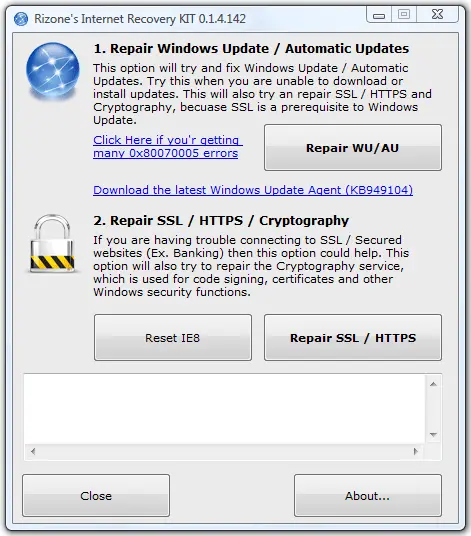In the following simple solution, I'll show you how to attempt to Repair Windows Update or Automatic Updates automatically by using an innovative little tool called "Rizone's Internet Recovery Kit". This tool can also be used in an attempt to repair SSL/HTTPS/Cryptography if your having troubles connecting to secured websites. I.E. Bank Account logins, PayPal etc.
Repairing Windows Update using Internet Recovery Kit

- Authors Website: Project Page
- Developer: Created by Rizone Technologies
Warning: This software is provided 'as-is', without any express or implied warranties whatsoever. In no event will the authors, partners or contributors be held liable for any damages, claims or other liabilities direct or indirect, arising from the use of this software.
- Download Rizone's Internet Recovery Kit and extract the contents to your PC.
- Click IntRec.exe and follow the onscreen instructions.
Other Methods to Repair Windows Update
Repairing Windows Update can be more complicated and involve several other steps depending on the nature of the issue you're encountering. Here are some other general methods to troubleshoot and repair Windows Update:
Basic troubleshooting tips:
- Have you restarted your computer? Sometimes, a simple restart can resolve update issues.
- Have you checked your internet connection? Ensure you're connected for downloading the updates.
Run Windows Troubleshooter to Repair Windows Update
- Windows 10 and 11:
- Go to Settings > Update & Security > Troubleshoot.
- Select Additional troubleshooters (Windows 10) or Other troubleshooters (Windows 11).
- Click on Windows Update and then Run the troubleshooter.
- Windows 7 and 8:
- Go to Control Panel > System and Security > Troubleshoot common computer problems.
- Click on Fix problems with Windows Update.
Clear Windows Update Cache
- Stop Windows Update Service:
- Open Command Prompt as an administrator.
- Type the following to stop the Windows update service and press Enter;
net stop wuauserv
- Then type the following;
net stop bits
- Delete the SoftwareDistribution Folder:
- Navigate to C:\Windows\SoftwareDistribution.
- Delete all files and folders inside the "SoftwareDistribution" folder.
- Restart Windows Update Service:
- Open Command Prompt as an administrator.
- Type the following and press Enter;
net start wuauserv
- Then type the following and press Enter;
net start bits
Run System File Checker (SFC) and Deployment Imaging Service and Management Tool (DISM)
- Run SFC:
- Open Command Prompt as an administrator.
- Type the following and press Enter;
sfc /scannow
- Wait for the process to complete and follow any on-screen instructions.
- Run DISM:
- Open Command Prompt as an administrator.
- Type the following to run DISM;
DISM /Online /Cleanup-Image /CheckHealth
- If no issues are found, type;
DISM /Online /Cleanup-Image /ScanHealth
- And if issues are found, type;
DISM /Online /Cleanup-Image /RestoreHealth
Reset Windows Update Components
- Create a Batch File:
- Open Notepad.
- Copy and paste the following script into the file:
net stop bits net stop wuauserv net stop appidsvc net stop cryptsvc Del "%ALLUSERSPROFILE%\Application Data\Microsoft\Network\Downloader\qmgr*.dat" Del "%ALLUSERSPROFILE%\Microsoft\Network\Downloader\qmgr*.dat" Ren %Systemroot%\SoftwareDistribution SoftwareDistribution.bak Ren %Systemroot%\System32\catroot2 catroot2.bak net start bits net start wuauserv net start appidsvc net start cryptsvc - Save the file with a .bat extension (e.g., ResetWUC.bat).
- Right click the file and select Run as administrator.
Check for Malware
- Run a full system scan using Windows Defender or another trusted antivirus software to ensure that malware is not interfering with Windows Update.
Manually Installing Windows Updates
- Visit the Microsoft Update Catalog
- Use the Search to find the specific update you need.
- Download and install the update manually.
Advanced Troubleshooting
If the above methods do not resolve the issue, you may need to perform more advanced troubleshooting:
- Perform a System Restore:
- Go to Control Panel > Recovery > Open System Restore.
- Follow the prompts to restore your system to a point when Windows Update was functioning correctly.
- Repair Windows Install:
- Create a bootable Windows installation media using the Media Creation Tool.
- Boot from the installation media and select the option to repair your computer.
- Contact Microsoft Support: If all else fails, contacting Microsoft assistance may be necessary.
Following these steps should help resolve most issues related to Windows Update.